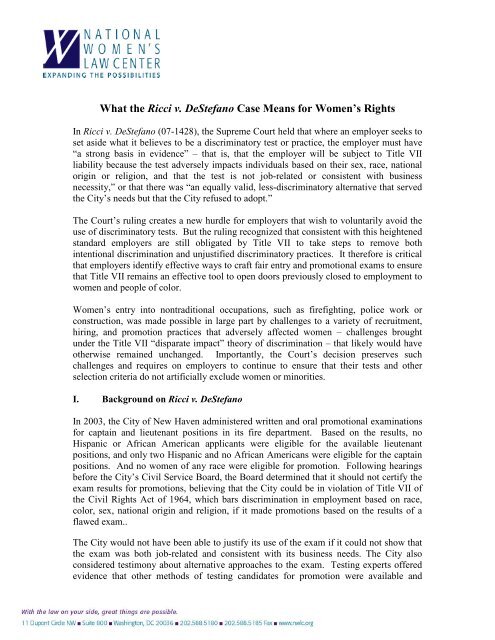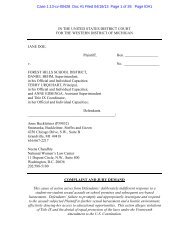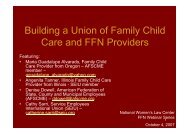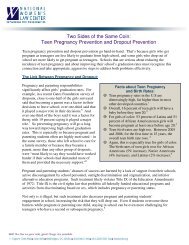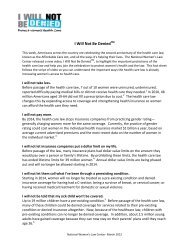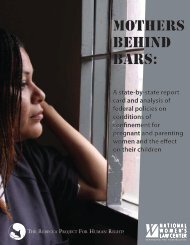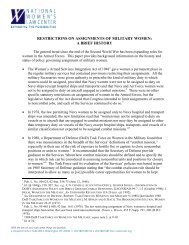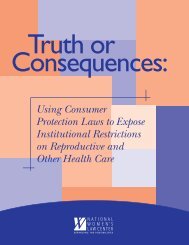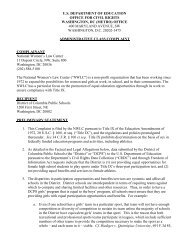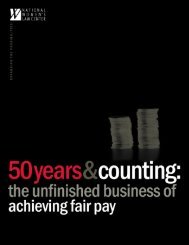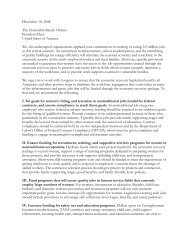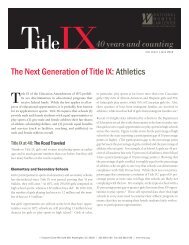What the Ricci v. DeStefano Case Means for - National Women's ...
What the Ricci v. DeStefano Case Means for - National Women's ...
What the Ricci v. DeStefano Case Means for - National Women's ...
You also want an ePaper? Increase the reach of your titles
YUMPU automatically turns print PDFs into web optimized ePapers that Google loves.
<strong>What</strong> <strong>the</strong> <strong>Ricci</strong> v. <strong>DeStefano</strong> <strong>Case</strong> <strong>Means</strong> <strong>for</strong> Women’s Rights<br />
In <strong>Ricci</strong> v. <strong>DeStefano</strong> (07-1428), <strong>the</strong> Supreme Court held that where an employer seeks to<br />
set aside what it believes to be a discriminatory test or practice, <strong>the</strong> employer must have<br />
“a strong basis in evidence” – that is, that <strong>the</strong> employer will be subject to Title VII<br />
liability because <strong>the</strong> test adversely impacts individuals based on <strong>the</strong>ir sex, race, national<br />
origin or religion, and that <strong>the</strong> test is not job-related or consistent with business<br />
necessity,” or that <strong>the</strong>re was “an equally valid, less-discriminatory alternative that served<br />
<strong>the</strong> City’s needs but that <strong>the</strong> City refused to adopt.”<br />
The Court’s ruling creates a new hurdle <strong>for</strong> employers that wish to voluntarily avoid <strong>the</strong><br />
use of discriminatory tests. But <strong>the</strong> ruling recognized that consistent with this heightened<br />
standard employers are still obligated by Title VII to take steps to remove both<br />
intentional discrimination and unjustified discriminatory practices. It <strong>the</strong>re<strong>for</strong>e is critical<br />
that employers identify effective ways to craft fair entry and promotional exams to ensure<br />
that Title VII remains an effective tool to open doors previously closed to employment to<br />
women and people of color.<br />
Women’s entry into nontraditional occupations, such as firefighting, police work or<br />
construction, was made possible in large part by challenges to a variety of recruitment,<br />
hiring, and promotion practices that adversely affected women – challenges brought<br />
under <strong>the</strong> Title VII “disparate impact” <strong>the</strong>ory of discrimination – that likely would have<br />
o<strong>the</strong>rwise remained unchanged. Importantly, <strong>the</strong> Court’s decision preserves such<br />
challenges and requires on employers to continue to ensure that <strong>the</strong>ir tests and o<strong>the</strong>r<br />
selection criteria do not artificially exclude women or minorities.<br />
I. Background on <strong>Ricci</strong> v. <strong>DeStefano</strong><br />
In 2003, <strong>the</strong> City of New Haven administered written and oral promotional examinations<br />
<strong>for</strong> captain and lieutenant positions in its fire department. Based on <strong>the</strong> results, no<br />
Hispanic or African American applicants were eligible <strong>for</strong> <strong>the</strong> available lieutenant<br />
positions, and only two Hispanic and no African Americans were eligible <strong>for</strong> <strong>the</strong> captain<br />
positions. And no women of any race were eligible <strong>for</strong> promotion. Following hearings<br />
be<strong>for</strong>e <strong>the</strong> City’s Civil Service Board, <strong>the</strong> Board determined that it should not certify <strong>the</strong><br />
exam results <strong>for</strong> promotions, believing that <strong>the</strong> City could be in violation of Title VII of<br />
<strong>the</strong> Civil Rights Act of 1964, which bars discrimination in employment based on race,<br />
color, sex, national origin and religion, if it made promotions based on <strong>the</strong> results of a<br />
flawed exam..<br />
The City would not have been able to justify its use of <strong>the</strong> exam if it could not show that<br />
<strong>the</strong> exam was both job-related and consistent with its business needs. The City also<br />
considered testimony about alternative approaches to <strong>the</strong> exam. Testing experts offered<br />
evidence that o<strong>the</strong>r methods of testing candidates <strong>for</strong> promotion were available and
suggested that alternative tests might not have an adverse effect on minority candidates.<br />
Twenty white firefighters, including one Hispanic firefighter, filed suit, claiming that <strong>the</strong><br />
decision by <strong>the</strong> City to not certify <strong>the</strong> results was reverse discrimination.<br />
The district court rejected <strong>the</strong> firefighters’ arguments that <strong>the</strong> City was required to certify<br />
<strong>the</strong> results of a test that it believed violated Title VII. A panel of <strong>the</strong> Court of Appeals <strong>for</strong><br />
<strong>the</strong> Second Circuit affirmed <strong>the</strong> district court decision in a summary order, and <strong>the</strong> full<br />
Circuit denied rehearing of <strong>the</strong> panel’s decision. The firefighters petitioned <strong>for</strong> certiorari,<br />
and <strong>the</strong> Supreme Court heard oral argument in <strong>the</strong> case in April, 2009.<br />
The Supreme Court’s decision that employers must have “a strong basis in evidence”<br />
be<strong>for</strong>e discarding a discriminatory test or practices represents a shift in <strong>the</strong> standard<br />
traditionally guiding employers confronting discriminatory practices and potentially<br />
undermines <strong>the</strong> decades of ef<strong>for</strong>ts to expand opportunities <strong>for</strong> women in nontraditional<br />
areas of employment.<br />
II.<br />
Disparate Impact <strong>Case</strong>s Have Expanded Opportunities <strong>for</strong> Women<br />
Employment practices that impose a disparate impact, like <strong>the</strong> promotional test used in<br />
<strong>Ricci</strong>, have closed opportunities <strong>for</strong> women in nontraditional fields. In some cases, a<br />
practice disadvantages women without any relationship to job per<strong>for</strong>mance. Indeed, in<br />
such a case, a seemingly neutral practice may actually conceal an employer’s intent to bar<br />
women from a job. For example, employers have historically implemented height,<br />
weight or strength requirements in police departments, fire departments, and in<br />
correctional facilities that are not at all related to job per<strong>for</strong>mance; in many cases, <strong>the</strong>se<br />
practices were designed to maintain predominantly male working environments.<br />
In addition, o<strong>the</strong>r employment practices covered by <strong>the</strong> bar against disparate impact<br />
discrimination reflect stereotypes about <strong>the</strong> skills required <strong>for</strong> a position but, upon<br />
examination, <strong>the</strong>re are alternative practices that may both satisfy job per<strong>for</strong>mance<br />
demands and allow <strong>for</strong> a diverse work<strong>for</strong>ce. Both <strong>for</strong>ms of discrimination covered by <strong>the</strong><br />
disparate impact standard serve as roadblocks to <strong>the</strong> advancement of women in<br />
nontraditional fields.<br />
The examples below illustrate just a few of <strong>the</strong> employment practices, including tests and<br />
o<strong>the</strong>r seemingly neutral requirements, that courts have struck down under <strong>the</strong> Title VII<br />
disparate impact standard.<br />
Height and Weight Requirements:<br />
Title VII’s ban on disparate impact discrimination allowed individuals to challenge – and<br />
as a result largely eliminated – <strong>the</strong> use of height and weight requirements that<br />
disproportionately excluded women from firefighting, construction and police work. For<br />
example:<br />
<br />
The Supreme Court first applied <strong>the</strong> disparate impact standard to remedy sexbased<br />
disparate impact discrimination when it struck down <strong>the</strong> Alabama State<br />
Penitentiary System’s minimum height and weight requirements <strong>for</strong> correctional<br />
<strong>National</strong> Women’s Law Center<br />
www.nwlc.org<br />
June 2009 2 2
counselors. The requirements had a significant disparate impact on women – 33<br />
percent of women were ineligible <strong>for</strong> <strong>the</strong> positions because of <strong>the</strong> weight<br />
requirements and 22 percent of women were ineligible because of <strong>the</strong> height<br />
requirements. And only 1.28% and 2.35% of men were excluded by <strong>the</strong> respective<br />
height and weight requirements. The Supreme Court held that Alabama offered<br />
no evidence that ei<strong>the</strong>r height or weight were necessary qualifications <strong>for</strong><br />
correctional counselor positions. Although <strong>the</strong> state argued that height and weight<br />
were related to <strong>the</strong> strength needed <strong>for</strong> <strong>the</strong> position, <strong>the</strong>re was no evidence<br />
correlating height and weight requirements to strength. (Dothard v. Rawlinson,<br />
433 U.S. 321 (1977)).<br />
<br />
The Ninth Circuit struck down <strong>the</strong> height requirements utilized by <strong>the</strong> Los<br />
Angeles Police Department (LAPD) because <strong>the</strong>y were not job related and had a<br />
disparate impact on women, who tend to be shorter than men. (Blake v. City of<br />
Los Angeles, 595 F.2d 1367 (9th Cir. 1979)).<br />
Strength & Physical Tests:<br />
The disparate impact standard has led to changes to employer physical ability and<br />
strength tests. Although some positions are physically demanding, <strong>the</strong> tests have in some<br />
cases been designed in ways that are unrelated to <strong>the</strong> job and have served as part of a<br />
strategy to exclude women from nontraditional fields.<br />
<br />
<br />
The Eighth Circuit recently struck down a newly implemented strength test used<br />
<strong>for</strong> workers in a sausage factory. The test was not job related; in fact, it was more<br />
physically demanding than <strong>the</strong> actual job. And it had gross disparate impact on<br />
women – <strong>the</strong> percentage of women hired to work in <strong>the</strong> sausage factory fell from<br />
47 percent to 15 percent after <strong>the</strong> employer implemented <strong>the</strong> strength test.<br />
Women who had worked in <strong>the</strong> factory along side men <strong>for</strong> years were unable to<br />
pass it. (Equal Employment Opportunity Comm’n v. Dial, 469 F.3d 735 (8th Cir.<br />
2006)).<br />
A court struck down a physical agility test used by a fire department in Rhode<br />
Island. The test’s designer admitted that <strong>the</strong> test favored men because it<br />
emphasized upper body strength, an area where men tend to outper<strong>for</strong>m women.<br />
And <strong>the</strong> fire department was unable to show that <strong>the</strong> physical test was job-related.<br />
In fact, <strong>the</strong> plaintiff per<strong>for</strong>med her job as a part-time firefighter without having<br />
passed <strong>the</strong> test and <strong>the</strong>re was no evidence that part-time firefighters required<br />
different skills from fulltime firefighters. (Legault v. aRusso, 842 F.Supp. 1479<br />
(D.N.H. 1994)).<br />
Oral and Written Examinations That Disadvantage Women:<br />
The disparate impact standard has also led courts to strike down discriminatory employer<br />
written and oral examinations. These tests have in some cases been designed in ways that<br />
are unrelated to job requirements and have served as part of a strategy to exclude women<br />
from nontraditional fields.<br />
<strong>National</strong> Women’s Law Center<br />
www.nwlc.org<br />
June 2009 3 3
The Sixth Circuit struck down <strong>the</strong> examination process used by <strong>the</strong> Toledo, Ohio<br />
Police Department in hiring and promotions. The exams consisted of a<br />
combination of written tests, physical ability tests, and a structured oral interview.<br />
The court struck down both <strong>the</strong> physical test portion and <strong>the</strong> structured interview,<br />
finding that nei<strong>the</strong>r was valid nor appropriately job-related. The court found that<br />
<strong>the</strong> grading of <strong>the</strong> interviews “was subject to a host of errors resulting from a lack<br />
of standardized conditions, rater bias, and <strong>the</strong> lack of criteria on which to judge<br />
<strong>the</strong> degree of correctness of answers.” The court concluded that “<strong>the</strong> structured<br />
interview was rife with <strong>the</strong> potential <strong>for</strong> discrimination.” (Harless v. Duck, 619<br />
F.2d 611 (6th Cir. 1980)).<br />
The Ninth Circuit upheld a district court verdict striking down a written<br />
examination used by <strong>the</strong> City of Los Angeles Sheriff’s Department because it had<br />
a disparate impact on female applicants. Out of 79 women who applied <strong>for</strong><br />
promotion <strong>for</strong> Sergeant, only 10 scored high enough <strong>for</strong> consideration, and only<br />
four were ultimately promoted. In comparison, of <strong>the</strong> 1312 men who took <strong>the</strong><br />
exam, 127 were ultimately promoted. Similar results occurred in o<strong>the</strong>r years of<br />
testing. (Bouman v. Block, 940 F.2d 1211 (9th Cir. 1991)).<br />
O<strong>the</strong>r Standards That Disadvantage Women:<br />
<br />
A court struck down a construction site policy prohibiting bathroom breaks. The<br />
employer told its female crane operators to follow <strong>the</strong> model set by <strong>the</strong>ir male<br />
colleagues and urinate off <strong>the</strong> back of <strong>the</strong> crane while working. This policy was<br />
not job-related and had a disparate impact on <strong>the</strong> ability of women to be employed<br />
as crane operators. (Johnson v. AK Steel Corp, 2008 WL 2184230 (S.D. Ohio<br />
May 23, 2008)).<br />
Because of <strong>the</strong> disparate impact standard, courts have been able to root out discriminatory<br />
exams and o<strong>the</strong>r requirements and in <strong>the</strong>ir place implement standards that are do not<br />
disproportionately exclude women and that more accurately screen <strong>for</strong> qualified<br />
employees.<br />
The Supreme Court’s Decision in <strong>Ricci</strong> Allows Employers to Continue to Prevent<br />
Discriminatory Standards<br />
Despite <strong>the</strong> Court’s departure from traditional interpretations of Title VII, employers<br />
must continue to take steps to eliminate practices that unfairly disadvantage women in <strong>the</strong><br />
workplace. The Court rejected arguments made by <strong>the</strong> white firefighters that an<br />
employer must be found by a court to be in violation of <strong>the</strong> disparate impact provision of<br />
Title VII be<strong>for</strong>e it can discard <strong>the</strong> results of a discriminatory practice. This, <strong>the</strong> Court<br />
held, was “overly simplistic” and would undermine Congress’s intent that ‘voluntary<br />
compliance be ‘<strong>the</strong> preferred means of achieving <strong>the</strong> objectives of Title VII.’” Slip Op. at<br />
21. Instead, employers must continue to evaluate <strong>the</strong>ir practices and, where practices<br />
serve as discriminatory barriers <strong>for</strong> employment or promotion, must address those<br />
barriers. Indeed, <strong>the</strong>re are steps that employers can take during <strong>the</strong> design phase of a test<br />
to ensure <strong>the</strong>ir tests are fair. And even after administering a test, if <strong>the</strong>re is a strong basis<br />
<strong>National</strong> Women’s Law Center<br />
www.nwlc.org<br />
June 2009 4 4
in evidence that <strong>the</strong> test would violate Title VII’s disparate impact standard, employers<br />
must take steps to remedy <strong>the</strong> discrimination.<br />
NWLC filed an amicus brief in <strong>the</strong> case, which is available here:<br />
http://nwlc.org/pdf/NWLC-Partnership%20<strong>Ricci</strong>%20Brief%20Final.pdf.<br />
<strong>National</strong> Women’s Law Center<br />
www.nwlc.org<br />
June 2009 5 5


